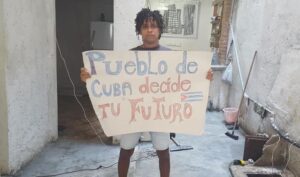In another era, the detention of a young Cuban dissident may have gone completely unnoticed. But when the rapper Denis Solís (below) was arrested by the police, he did something that has only recently become possible on the island: He filmed the encounter on his cellphone and streamed it live on Facebook, the Times reports:
The stream last month prompted his friends in an artist collective to go on a hunger strike, which the police broke up after a week, arresting members of the group. But their detentions were also caught on cellphone videos and shared widely over social media, leading hundreds of artists and intellectuals to stage a demonstration outside the Culture Ministry the next day….The marches were small, but were among the first independently organized demonstrations on the island in decades.
“It is this awakening of civil society, facilitated by the spread of the internet and social media, which is posing this challenge to the government,” said William LeoGrande, a Cuba specialist at American University. “To what extent does a political system which prides itself on control allow the kind of civil society expression that we’ve seen growing?”
The Economist podcast examines the surge of the artist-led protest movement in Cuba, where dissent on any scale is a dangerous proposition.
They Call Us Enemies of the Cuban People https://t.co/Ou37vxqbsy
— Democracy Digest (@demdigest) December 10, 2020
Anger rather than fear is the widespread sentiment among Cubans — a constant, built-in discomfort, adds Carlos Manuel Álvarez, the author of “La Tribu,” a collection of chronicles on Cuba after Fidel Castro, and the novel “The Fallen.” We’re fed up with blind, doctrinaire zeal. Navigating Communism is like trying to cross a cobblestone road in high heels, trying not to fall, feigning normalcy. Some of us end up twisting our ankles, he writes for the Times:

Denis Solís
What the San Isidro movement epitomizes is the cry of a wounded country. The movement has become the most representative group of national civil society, bringing together Cubans of different social classes, races, ideological beliefs and generations, both from the exile community and on the island.
The group’s resistance has lasted for several years, and no one has been able to silence its members. Nor does it seem that the group endured this most recent repression in vain. The day after we were removed from the headquarters, hundreds of young people and artists gathered outside the Ministry of Culture to demand full recognition of independent cultural spaces and an end to ideological censorship in art. RTWT
Cuban historian and essayist, Rafael Rojas, told DW (above) that the Cuban government’s decision to break the dialogue with the critical artists means that from now on repression “will be more expeditious” as the security apparatus now has “the green light to act against protesters. Now they “have the green light to act against young protesters.”
Osmel Adrián Rubio Santos, a gay man who is just 18-years-old, joined the San Isidro Movement in September, but he had already begun his fight for human rights on the Communist island. Rubio told the Washington Blade in an exclusive interview that he joined the movement because he wanted to peacefully protest Solís’ arrest and conviction.
“We say that when they mess with one of us, they mess with all of us,” said Rubio, who added he has never felt discriminated against within the group.
Members of the San Isidro Movement “have become targets of continual harassment and arbitrary detentions by the regime,” said Acting Assistant Secretary for Western Hemisphere Affairs Ambassador Michael G. Kozak.
“But there is a broader rejection of moves to repress free expression, especially Decree Number 349, which forces artists to seek the government’s permission to perform, even in private spaces,” he added. “It also gives the regime the power to suspend any performance at will – subjecting all expressions of art in Cuba to the regime’s censorship.”
The World Movement for Democracy this week condemned Cuban authorities’ arrest of activist and artist Solís, a member of the San Isidro Movement (MSI).







